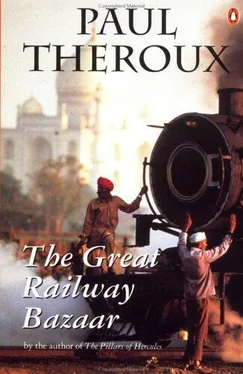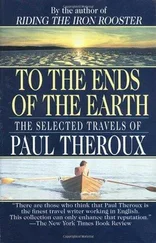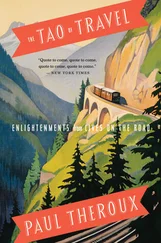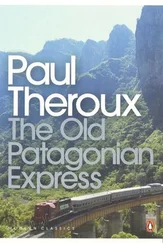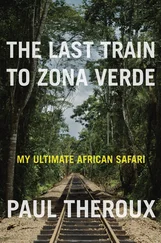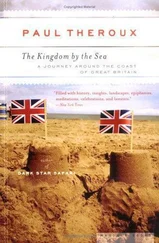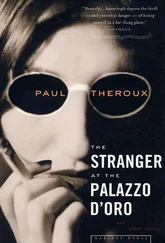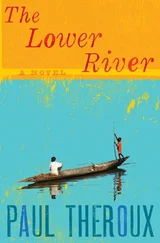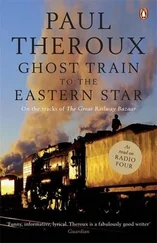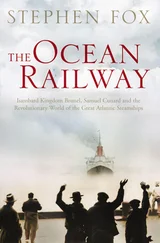Hanging on the balcony rail at the front of the train, I could see the line stretching before us, and beyond that the yellow ruined landscape, bare of trees, at the horizon of which Bien Hoa lay, a jumble of grey roofs and chimneys. The wind stank of excrement, and all along the tracks there was a vile flood of shit, worse than anything I had seen in India, brimming right up to the line and still flowing from open drains that led down the bank from settlements of huts. They were not crudely built squatters' shacks: these were small houses, built by contractors, whose existence had some official sanction. The houses with no drains. They were appropriate in a country where great roads led nowhere, where planes flew to no purpose, and the government was just another self-serving tyranny. The conventional view was that the Americans had been imperialists; but that is an inaccurate jibe. The American mission was purely sententious and military; nowhere was there evidence of the usual municipal preoccupations of a colonizing power – road-rnend-ing, drainage, or permanent buildings. In Saigon, the embassy and the Abraham Lincoln Library exhausted the services of the one architect who was sent in nine years. These two buildings will survive an offensive because that architect learned to incorporate a rocket-screen into a decorative feature of the outside wall – but this is not much of an achievement compared to the French-built post office, cathedral, the several schools, the solid clubs like the Cercle Sportif Saigonnais, and all the grand residences, of which Cobra One's was a fairly modest example. And out here in the suburbs of Bien Hoa, created by the pressure of American occupation, the roads were falling to pieces and cholera streamed into the back-yards. Planning and maintenance characterize even the briefest and most brutish empire; apart from the institution of a legal system there aren't many more imperial virtues. But Americans weren't pledged to maintain. There is Bien Hoa Station, built fifty years ago. It is falling down, but that is not the point. There is no sign that it was ever mended by the Americans; even sagging under its corona of barbed wire it looks a good deal sturdier than the hangars at Bien Hoa airbase.
'If the VC had hit this train,' said Dial at Bien Hoa Station, hopping off the engine, 'we would have been the first to get snuffed.'
That afternoon I gave a lecture – my usual vapouring about the novel – at Van Hanh University in Saigon. It elicited a number of antagonistic questions about the position of blacks in America, which I replied to as honestly as I could. Afterwards the rector, the Venerable Thich Huyen-Vi, a Buddhist monk, gave me an inscribed copy of his doctoral thesis, 'A Critical Study of The Life and Works of Sariputta Thera', and I went off to the Cercle Sportif.
'Here we are in beleaguered Saigon,' said Cobra One. He took me around the ten acres where Chinese, Vietnamese, and perhaps a dozen languid Frenchmen were playing games (badminton, tennis, fencing, judo, ping-pong, bowling) under the lighted trees. We had a game of billiards and then went to a restaurant. There were lovers purring at some tables and ' – opening a branch' drifted from a group of men. Cobra One said, 'Here we are in beleaguered Saigon.' We went to a nightclub on Tu Do, Saigon's main street. It was very dark inside. We were served with ice cubes in our glasses of beer. Then a red light came on and a Vietnamese girl in a miniskirt sang a quick-tempo version of 'Where Have All the Flowers Gone?' The heads bobbing in the semidarkness were those of people dancing spiritedly to the song. I saw Cobra One gesturing at the end of the table and heard, just above the singer's twanging voice, ' – beleaguered Saigon'.
The next day I flew – there was no train – to the delta town of Can Tho in a plane that had a wrinkled silver fuselage, like tinfoil from an old cigarette pack. Can Tho was once the home of thousands of GIs. With the brothels and bars closed, it had the abandoned look of an unused fairground after a busy summer. In all that decrepitude a wilfulness was revealed: we didn't want to stay in Vietnam, and so no vision of the country, except abstract notions of political and military order, were ever formed. The airport at Can Tho was almost destroyed and the main street was riddled with potholes; all the recent buildings had a tawdry temporary design – prefabs, huts, shelters of plywood. They will fall down soon -some already have been looted and pulled down for the lumber – and in a matter of time, very few years, there will be little evidence that the Americans were ever there. There are poisoned rice fields between straggling fingers of the Mekong Delta and there are hundreds of blond and fuzzy-haired children, but in a generation even these unusual features will change.
THE HUE-DANANG PASSENGER TRAIN
From the air, the grey unreflecting water of the South China Sea looked ice cold, there were round Buddhist graves all through the marshes, and the royal city of Hue lay half-buried in drifts of snow. But this was wet sand, not snow, and those circular graves were bomb craters. Hue had a bizarre appearance. There had been plenty of barbed wire on the barricades but little war damage in Saigon; in Bien Hoa there were bombed-out houses; in Can Tho stories of ambushes and a hospital full of casualties. But in Hue I could see and smell the war: it was muddy roads rutted by army trucks and people running through the rain with bundles, bandaged soldiers tramping through the monsoon slime of the wrecked town or peering across their rifle barrels from the backs of overloaded trucks. The movements of the people had a distressed simultaneity. Symmetrical coils of barbed wire obstructed most streets, and houses were sloppily sandbagged. The next day, in the train, Cobra One (who had come with Cobra Two and Dial for the ride) said, 'Look – every house has its own bullet hole!' It was true: few houses were without a violent gouge and most had a series of ragged plugs torn out of their walls. The whole town had a dark brown look of violation, the smirches of raids among swelling puddles. It held some traces of imperial design (Vietnamese, French) but this delicacy was little more than a broken promise.
And it was very cold, with the sudden chill from the low sky and the drizzle clinging in damp rooms. I paced up and down, hugging myself to keep warm, during my lecture at the University of Hue – a colonial building, in fact, not academic at all, but rather what was once a fancy shop called Morin Brothers, which outlying planters used as a guest house and provisioner. I lectured in one of the former bedrooms, and from the windy balcony I could see the neglected courtyard, the cracked fishpond, the peeling shutters on the windows of the other rooms.
Later we drove to a bluff above the Royal Tombs, on the Perfume River. 'That's VC territory,' said Mr McTaggart, the local USIS official. He was a genial white-haired man, who cooked his own meals and sometimes rode his bicycle out here and practised his Vietnamese with the sentries on the bluff. Across the river, the Viet Cong territory was a number of scalped hills: it had been defoliated. But there was still shooting now and then. An ARVN boat would chug close to the enemy bank and spend an afternoon firing into the hills, not at a particular target, but more like the French man-of-war in Heart of Darkness that aimlessly – insanely, Conrad says – shells the African jungle. I must come during the hot season, one of the Vietnamese said. Then I could hire a boat and a girl and bring some food, and I could spend a night on the river like this, making love and eating where it was cool.
I promised I would. We went to the tombs next. The older the buildings were in Hue, the better their state of preservation: last year's Quonset huts were falling to bits, Mr McTaggart's forty-year-old house was seedy but comfortable, the hundred-year-old Royal Tombs were in very good shape, although these had been made with second-hand materials, in accordance with Vietnamese custom (to stress humility) – old lumber and stone, broken pottery, and cracked tiles. There were tangled gardens and carved gateways with panting dragons crouched over the arches; and in the interior rooms, the dusty mausoleums, ancient women hobbled from artifact to artifact, lighting tapers to show us the French clock (its hands missing), the crystal candelabra, the gilt altars and the cabinets inlaid with mother-of-pearl, the peacock fans with moulting feathers ('She says they're from the French king'). The hands of the old ladies trembled as they held the flames of the tapers close to the tinder-dry treasures, and I was afraid they'd set the place alight. When we left they blew out all the candles and remained in the dark tombs. It was a city people were constantly fleeing, but here in the tombs the old ladies -retainers to kings of the twenties and thirties – never left. They ate and slept in the precincts of the royal mausoleum.
Читать дальше
